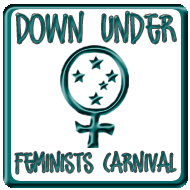I’m excited to be hosting the 99th Down Under Feminist’s Carnival. This is my third time collating – and I’m always blown away by the quality and strength of the feminist blogosphere. Feminist writing in New Zealand and Australia is so broad and diverse and it’s always exciting to find out what’s being written and analysed on a whole range of topics. Get your browsers/phones/e-readers ready because there’s a lot of fabulous and interesting and inspiring material to get through!
I’ve been a bit slack as a blogger. I must admit to being generally disengaged with politics and to reading feminist politics for a while now. I haven’t meant to go so long between posts. There are a variety of reasons for my blogging absence (mostly: small children; but also: needing to save my mental health by not turning on the news!) but engaging with all these amazing writers, I’m inspired to get back to blogging again. Please, someone, hold me to this. 🙂
But enough waffle from me. Lets get onto the good stuff. Without further ado, I present the July 2016 DUFC. Get your reading gear around these awesome links:
RACISM/INTERSECTIONS
- Racism in Australia seemed to reach new lows of atrociousness this month, with 4 Corners exposé of the assault, tear-gassing and abuses of indigenous children in a Northern Territory youth detention centre. This article from the SMH outlines some of the horror if you haven’t heard about it already. Gillian Triggs calls for Inquiry into Youth Detention Abuse. [warning: graphic images in that article] Triggs, who is President of the Human Rights Commission has argued that this kind of systemic abuse in NT are part of a wider culture of human rights abuses and cover-ups currently occuring in Australia, both onshore and offshore detention.
- With the Federal election, we’ve also seen the return to the political spotlight of Pauline Hanson. At Daily Life Celeste Liddle writes about the current political climate and why We shouldn’t be surprised by the return of Pauline Hanson. Liddle writes:
Since Hanson’s first election, rather than simply avoiding backlash, politicians have actively drawn on the racist undercurrent of Australian society to win elections. The deliberate focus on “stopping the boats” following the Tampa Affair in 2001 is one jarring example of this happening. Worse, it proved successful and has become a standard tactic used by both the Coalition and the Labor Party in subsequent elections.
- No Place for Sheep responds to political commentator Waleed Aly’s discussion of primetime chatshow host Sonia Kruger’s bigoted comments about banning Muslims from migrating to Australia: Pray for the Bigots.
- Ann Deslandes wrote a fantastic piece for New Matilda about white privilege in Australia and abroad, in the context of the upcoming Olympic Games: Australia Packs Its Prejudice And Heads To Rio.
- Celeste Liddle writes at Daily Life: Magnolia Maymuru wasn’t the only Aboriginal finalist of Miss World Australia. Why weren’t the others recognised?
FAMILY/PARENTING
- At Flip That Script is a great post about inappropriate adult comments about children. I love this piece because I’ve heard quite a few of the Yucky Adult Comment examples, usually while at the playground with my little ones, and I never know what to say… I’m guilty of just leaving an awkward silence, or smiling along while thinking “did you really just say that?” when hearing comments like these. Let the children play. Don’t let yucky adult comments get in the way.
- Over at Wonderously Other is a lovely piece about how hard it can be returning to paid work after having a baby: The Life of a Working Mother.
- There’s a fantastic piece at ABC News site by Samantha Selinger-Morris titled Scratching beneath the surface of motherhood regret. This one really struck a chord with me, and it’s a topic that I’ve pondered writing about myself for this here blog, but because it’s so personal I keep putting it off. However, the personal is political, as the saying goes, so one day I will write about my own experiences of maternal ambivalence (as the above article calls it) and how tricky it feels to even admit to that in public. Someone needs to hold me to it though because I will procrastinate.
- Elswhere, at Cesca at MyFlatPackLife discusses how patronising and irritating it is to be judged for formula-feeding your baby: Bottle vs Breast.
LIFE/HEALTH/DEATH
- Over at Write Handed, Sarah Wilson writes a very personal piece about how phoning Lifeline helped her and why New Zealand funding for it should be reinstated: Lifeline: It Literally Is
- Scarlet Harris writes at SBS about the positives of singledom: Sometimes it’s just easier being single
- Ginger Gorman writes a a touching tribute to blogger Elizabeth Caplice, who passed away last month from cancer: ‘I get to do it on my terms. I like that’. I hadn’t come across her blog before but her words are powerful and honest and although I’ve not read many of her posts, I’m sorry to hear of her death.
THE BODY
- Elise Holland writes at The Conversation about the ‘fitspiration movement’: Why the ‘fitspo’ movement is damaging to women.
- At Feminartsty Scarlet Harris writes about femininity and Trading in the Beauty Economy.
VIOLENCE
- Van Badham writes passionately about her appearance on the ABC’s panel show, where she didn’t get a chance to argue the need for greater funding and support services for women fleeing domestic violence, because one of the panellists kept interupting and making it all about himself: I’m still reeling from Q&A but not because I was called hysterical
- Jane Gilmour published her piece about the privitisation of the 1800-RESPECT crisis hotline for domestic violence because no news sites considered it newsworthy enough. That says a lot. Great and important read here: 1800 RESPECT, risking women’s lives for ideology and “women’s issues” in the news. Gilmour writes:
Earlier this year, 1800 RESPECT asked the government for an additional $2.1 million from the government to provide resources to meet rapidly increasing demand. Instead, the Turnbull government has decided to spend $5 million ($2.9 million more than 1800 RESPECT need) to contract Medibank Health solutions to provide a triage service.
This new service, announced by the Department of Social Services (DSS), is not only predicted to dilute services to women in crisis, but it also poses serious, potentially life threatening, risk to privacy of data collected by the newly contracted provider, and significant safety risks to counsellors working on the hotlines.
DISABILITY
- In this post Please Call Me Disabled, Sarah Wilson writes beautifully about the process of accepting and identifying oneself as disabled.
- Blogger WillowDove urges people to consider wheelchair accessibility issues: Wheelchair ramps 101 – first steps. She writes:
If you are inviting someone who uses a wheelchair somewhere that they don’t know, but you do (or to your house/workplace), volunteer to talk about the access. Think about the venue and your guest ahead of this conversation but try not to draw too many conclusions for yourself. See yourself as the constable gathering information for the detective.
MEDIA/ POP CULTURE/ ARTS
- Over at Kill Your Darlings, Alexandra Heller-Nicholas writes about the latest Ghostbusters flick, which has three (gasp!) female leads: The first woman Ghostbuster. I particularly love this paragraph, especially for my new favourite word, misogybile:
With all the hype surrounding Paul Feig’s women-fronted Ghostbusters reboot, you’d think by the volume of misogybile from the Internet’s self-appointed guardians of male nostalgia that some great crime had been committed in the hallowed realm of contemporary light entertainment.
That’s all from me for now. I hope you get as much out of reading these pieces as I have. A big thank you to everyone who helped me put this together by sending me relevant links.
Interesting in hosting a carnival? Want to know more about the DUFC? Check out How it Works
The next edition of the Carnival – the big One Zero Zero – is planned for 5 September, 2016: by Chally at Zero at the Bone. Please help her out by sending submissions to chally.zeroatthebone [at] gmail [dot] com.
Until next time, femmo friends. Pondering Pen signing out.




